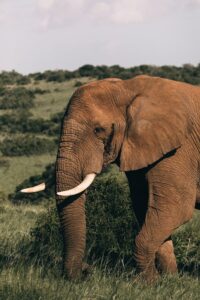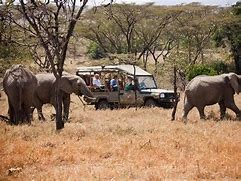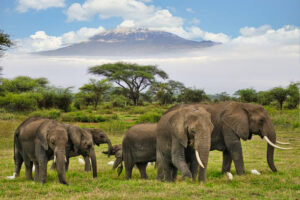Embark on a journey across two of Africa’s most iconic wilderness areas the Masai Mara National Reserve in Kenya and the Serengeti National Park in Tanzania. Spanning vast expanses of savannah, teeming with an astonishing array of wildlife, these legendary parks offer an unparalleled safari experience that will leave you spellbound. Combining the Masai Mara and Serengeti in a single itinerary allows you to witness the majestic Great Migration the annual movement of millions of wildebeest, zebras, and other ungulates as they traverse the plains in search of greener pastures. Beyond the migration, both parks boast diverse ecosystems, rich biodiversity, and breathtaking landscapes that make them must-visit destinations for any wildlife enthusiast or nature lover.
In this guide, we’ll take you through the essentials of planning a seamless journey that seamlessly combines the Masai Mara and Serengeti. From the best times to visit to travel logistics and safari experiences, prepare to embark on an unforgettable adventure across two of Africa’s most iconic safari destinations.
Understanding the Masai Mara and Serengeti:
Geography and Landscape:
- The Masai Mara is located in southwestern Kenya, while the Serengeti stretches across northern Tanzania.
- Both parks are part of the larger Serengeti-Mara ecosystem, known for its vast savannahs, acacia-dotted plains, and seasonal river crossings.
- The Mara River flows through both reserves, serving as a crucial lifeline for wildlife and a focal point during the Great Migration.
Wildlife Viewing:
- The Masai Mara and Serengeti are renowned for their exceptional wildlife populations, including the Big Five (lion, elephant, buffalo, leopard, and rhinoceros) and an array of other species.
- The Great Migration, one of nature’s greatest spectacles, sees millions of wildebeest, zebras, and gazelles moving between the two parks in search of fresh grazing grounds.
- Each destination offers unique wildlife encounters, with the Masai Mara known for its prolific predator sightings and the Serengeti for its expansive plains teeming with herbivores.
Cultural Immersion:
- Both parks are home to indigenous communities with rich cultural traditions, such as the Maasai in Kenya and various tribes in Tanzania.
- Visitors can engage in cultural activities like village visits, traditional dances, and learning about local customs and way of life.
Crafting Your Itinerary
Timing:
- Plan your visit during the Great Migration for an extraordinary wildlife spectacle. The timing varies slightly each year, but generally, it occurs from July to October.
- Consider the seasonal differences between the Masai Mara and Serengeti when planning your trip. For instance, the Serengeti’s dry season (June to October) offers optimal wildlife viewing, while the Masai Mara experiences its peak season during the same period.
Transportation at Masai Mara:
Fly into Nairobi, Kenya, or Kilimanjaro International Airport in Tanzania, depending on your chosen starting point.
- From Nairobi, you can either fly or drive to the Masai Mara. Flights offer convenience and time-saving benefits, while driving allows for scenic overland travel.
- Crossing the border between Kenya and Tanzania to reach the Serengeti typically involves ground transportation, either by road or organized safari transfer.
Accommodation at Masai Mara:
- Both the Masai Mara and Serengeti offer a range of accommodation options to suit various preferences and budgets, from luxury tented camps to rustic lodges.
- Consider staying at lodges or camps located strategically along the migratory route for prime wildlife viewing opportunities.
Game Drives and Activities:
- Plan game drives in both parks, led by experienced guides who are familiar with the wildlife movements and behavior patterns.
- Take advantage of hot air balloon safaris, walking safaris, and night drives for a more immersive experience and a chance to see nocturnal species.
Tips for Enhancing Your Experience:
Photography Opportunities:
- Both the Masai Mara and Serengeti offer unparalleled photography opportunities, especially during the Great Migration.
- Bring a quality camera with a telephoto lens to capture close-up shots of wildlife and breathtaking landscapes.
Responsible Travel at Masai Mara:
- Respect wildlife and adhere to park regulations to minimize your impact on the environment.
- Support local communities by purchasing handmade crafts directly from artisans and choosing eco-friendly accommodation options.
Weather Considerations at Masai Mara :
-
Pack appropriate clothing for varying weather conditions, including lightweight clothing for daytime safaris and warm layers for cool evenings and early mornings.
- Be prepared for potential rain showers, especially during the Masai Mara’s rainy season from November to May.
Flexibility:
- Remain flexible with your itinerary to adapt to wildlife sightings and other unexpected opportunities that may arise during your journey.
- Embrace the spontaneity of safari life, where every moment brings new discoveries and awe-inspiring encounters.
Conclusion: Combining the Masai Mara and Serengeti National Parks offers an unparalleled safari experience, showcasing the best of East Africa’s wildlife and landscapes. By carefully planning your itinerary, embracing cultural immersion, and remaining flexible during your journey, you’ll create memories to last a lifetime. Whether you’re witnessing the Great Migration, tracking the Big Five, or connecting with local communities, your adventure in these iconic parks promises to be truly unforgettable.





